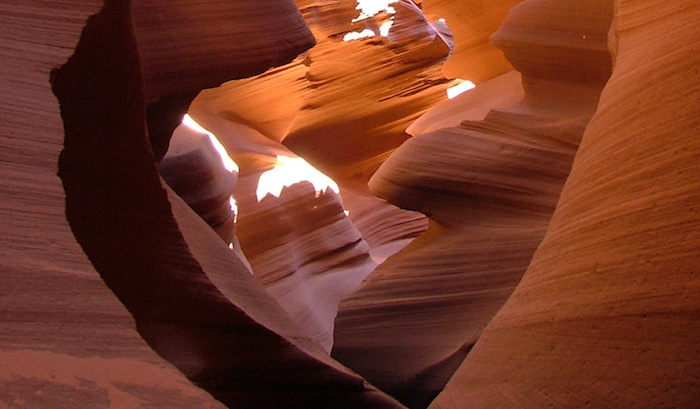Once a month here on the Molten Sulfur Blog, I run content taken from our book Archive: Historical People, Places, and Events for RPGs. This post, about Antelope Canyon, is one of eighty entries in Archive, each more gameable than the last!

Antelope Canyon
Corridors of Flowing Stone
Water and time have carved deep into the sandstone on Navajo land near Page, Arizona, forming a slot canyon with smooth, flowing walls. Antelope Canyon got its name from the stories told by local Navajo people, who say antelope graze along the canyon during winter, though it is mostly known for its interior. For centuries, flash floods, especially those occurring during monsoon season, have barraged the sandstone. The waters eroded the stone unevenly, creating smooth, rippling walls. Looking up to the surface from within, you can observe the smooth bumps of sandstone formed by the floods. It almost looks like sand dunes, or a choppy, reddish-orange sea. These waves can make travel through the canyon awkward, as they jut out, making some areas incredibly narrow and others wide. In some sections, the canyon is wide from the waist down, but tight otherwise. The waves also make light distribution just as uneven. Sometimes, only thin beams pierce the corridors while the rest is cloaked in shadow.
Antelope Canyon is comprised of the Upper and Lower canyons. The Upper Antelope Canyon is called Tsé bighánílíní or “the place where water runs through rocks” by the Navajo. The canyon can be entered from ground level, so you don’t have to climb in or out, and shafts of sunlight illuminating the canyon are more common in the Upper Antelope Canyon than in the Lower. For these reasons, the Upper Canyon is more frequently visited. The beams of light occur mostly in the summer months when the sun is most intense and high in the sky. The walls of the canyon stretch up to 120 feet tall, and because of their uneven flow, they filter out portions of the sunlight that shines down. In several areas, just small beams of bright, golden sun pierce all the way to the sandy canyon floor, creating a spotlight effect popular with photographers. Without these rays, the canyon walls are cloaked in velvety darkness.
The Lower Antelope Canyon is called Hazdistazí or “spiral rock arches” by the Navajo. From above, the canyon is just a sandy crevasse slithering through the surface. Metal stairways have been installed to make traveling through the Lower Canyon easier, and prior to the stairs there were ladders in some places. Even with these aids, the Lower Canyon is more difficult to hike than the Upper. The passageways are longer, narrower, and even footing is not always available. Climbing several flights of stairs is required if you want to get in or out. Despite these limitations, Lower Antelope Canyon still draws the attention of a few photographers and sightseers. Unlike Upper Antelope Canyon, this area is best illuminated by the sun during the early hours of the day or the late afternoon.
Due to flash flooding, visitors without guides are prohibited in the canyon. This rule has been heavily enforced since 1997, when twelve sightseers were caught in a flash flood. They were enjoying the meandering walls of sandstone while a summer storm raged upstream. The water drained toward nearby Lake Powell, carrying with it rocks and detritus. By the time it reached the twisting canyon, it was a wall of debris barreling towards the tourists with little warning beyond the roaring echoes of incoming water. The sudden river swept all of them up. Only one survived.
Antelope Canyon in Play
At the table, Antelope Canyon could be a time-sensitive dungeon. Perhaps your party needs to save someone trapped in the canyon or retrieve some treasure before a storm hits. If a flash flood strikes, your PCs might be split up and vulnerable as they search the dark canyons for each other. After the flood, debris could still tumble from above, creating a dangerous rain for unsuspecting or dazed travelers. Antelope Canyon might also be an interesting place for the PCs to be chased. Athletics and acrobatics checks might complicate efforts to escape, but PCs might leave behind traps to complicate pursuit. If it comes to combat, the canyon’s narrow confines make this a great place to stage an ambush.






